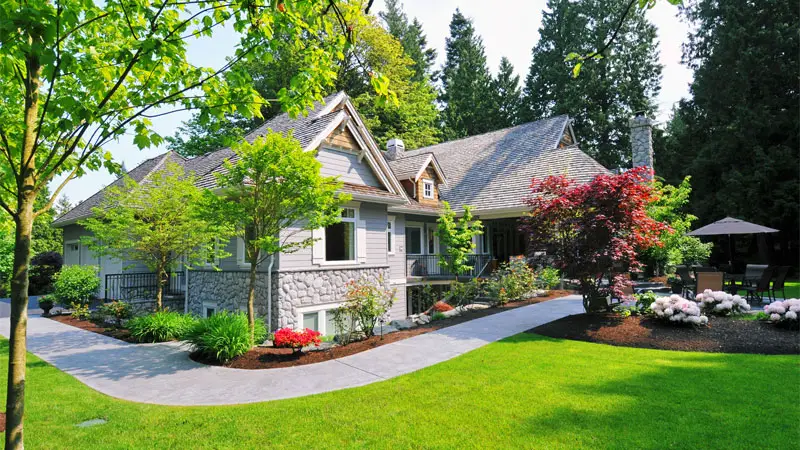Updated on August 19, 2022
Here are some valuable tips to consider before you start a DIY landscaping project or hire a professional.
Top 14 Landscaping Tips
1. Leave Enough Space
The most common mistake we see DIY landscapers make is not leaving enough room for trees and shrubs to grow.
Young plants look cute for the first few years, but become real problems as their mature size becomes evident. By that time, damage may have occurred to eaves troughs, fencing, etc, and plants that have crowded their neighbors and overgrown their space often look misshaped and really out of scale. Poorly sited trees block views and detract from your overall landscaping.
Be sure to read the plant tag and picture the plant at its mature size before digging the hole. If you want a blue spruce “look” but the space won’t accommodate a 60-foot tree that is 25 feet wide, then consider buying an evergreen shrub like a blue juniper, or spend the extra for a dwarf variety that will always remain small.
2. Doing Work in Phases
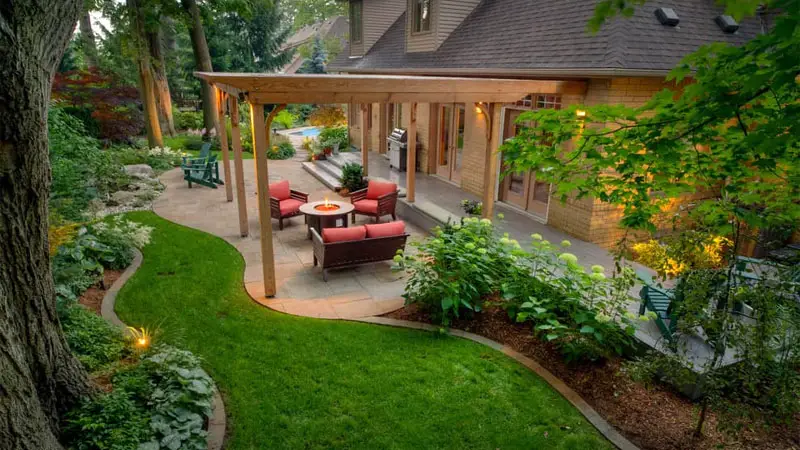
A great landscape doesn’t have to be completed all at one time. Doing it in stages breaks down the work into manageable chunks and also helps to ease possible financial strain. Just be sure the stages make sense and are done in the proper order.
Excavation, grading and installation of hardscaping elements such as walkways, decks and steps should be completed first. Planting gardens (softscaping) is generally the very last element in the overall landscape plan.
For instance, installing new stone steps and precast stone walkway may be enough for the first phase of the project with the balance of work done the following year, such as installing new gardens with new plant material, accent rocks and finishing the lawn with sod.
3. Call Before You Dig
Any digging in your yard using a shovel, pick or spade requires a “locate request” service. Underground, there could be gas pipelines, electrical services, telephone and cable TV, water and sewer connections and possibly distribution networks for utilities that serve your neighborhood.
Damaging underground services can have serious consequences: personal injury, loss of essential services, creating a safety risk for others, expensive restoration costs and potential legal actions.
4. Building Permits
A town permit is not required for many landscaping projects in many towns. However, if you plan to enclose a porch or build a deck higher than 24 inches, or construct a shed or gazebo larger than 108 square feet, you will require a permit.
You will also have to check town bylaws for any setbacks. Your neighbors will also appreciate it.
5. Drainage
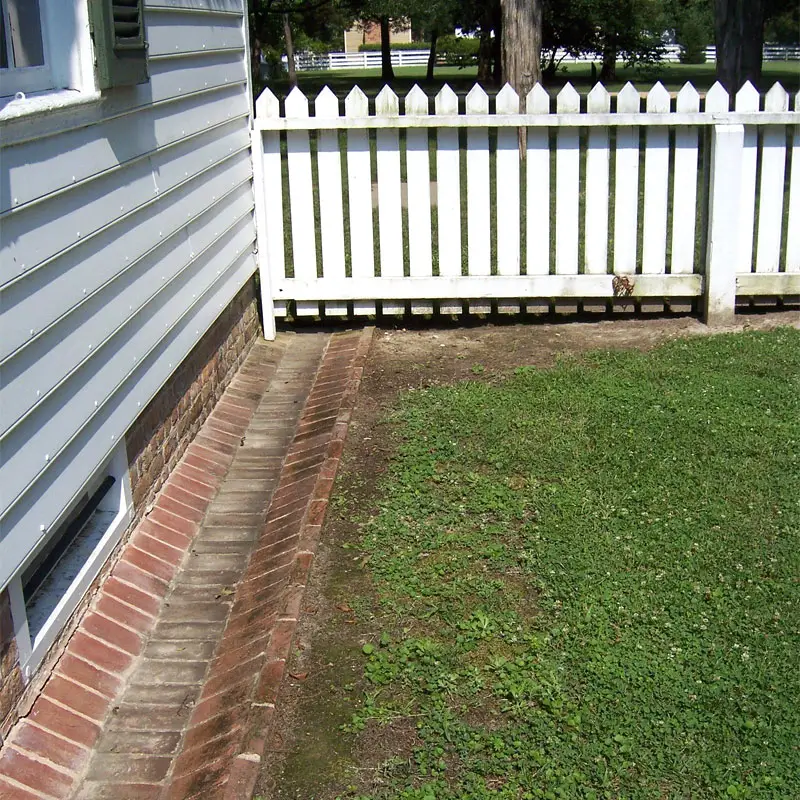
Altering water’s natural flow patterns can cause lots of future trouble, unless done correctly. Grading the land in a two percent slope away from the house will help to keep the foundation dry. Any retaining wall has to handle the moisture that will build up behind it.
Installing coarse, clear drain rock wrapped in filter cloth is an essential addition behind any retaining wall. All pathways, steps, and patios should be sloped a minimum of two percent to keep them free of water and ice.
As well, a two percent slope on newly installed lawns will help keep them puddle free. Effective handling of water runoff from downspouts is also important.
Related: 7 Rain Gutter Alternatives
6. Designing Safe, Comfortable Steps
Some steps are downright uncomfortable and unsafe, whether made from wood, stone or concrete. Professional landscapers use the formula 2R + T = 27. This means two times the Rise (stair height) plus the Tread (stair depth) should add up to 27.
For instance, if you have 7″ risers, then your tread depth should be 13. This formula always works to create comfortable and safe steps.
7. Pressure-Treated Lumber or Red Cedar for Outdoor Construction
Current market prices put PT lumber about half the cost of red cedar. Cedar is considered a higher quality wood; it has decay-proof natural protection that keeps it looking good for decades, whereas PT (spruce, pine fir) lumber has been chemically treated to resist rot and generally lasts around 20 years in outdoor situations.
Both PT and cedar can be stained, painted or left for a natural weathered look, but PT wood must first dry out before any coating is applied. Cedar lumber has been kiln dried and pieces are generally straighter.
Note: Construction labor prices should be the same, whether cedar or PT lumber is used in a project. Ask a landscaping company to give you a quote using both types.
8. What To Do With Problem Shady Areas
Grass thrives in sunny areas. Forcing sod to grow in heavy shade using fertilizer is not very effective. Our recommendation is to use the shade to your advantage, converting it into a garden full of shade loving plants, or creating a low-maintenance mass planting.
Our plant choice for mass planting in deep shade and tricky areas where nothing else will grow is geranium macrorhizum (bigroot geranium). It grows about 12-15 inches high, is almost evergreen with attractive green foliage turning bronze in fall, reliably hardy, grows in any soil and light conditions and spreads quickly into a dense planting but is not invasive.
A good landscaper can install thousands of these plants as required at a very reasonable rate, creating an appealing mass planting which provides a low maintenance, weed-free solution for any size area.
9. Water Features
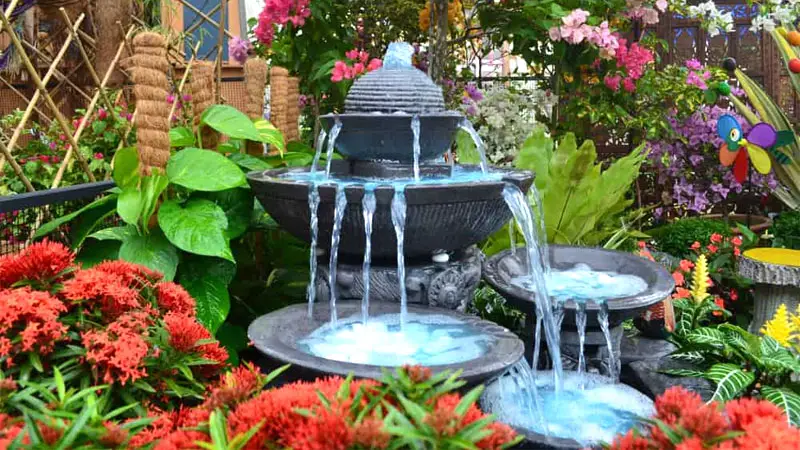
The sound of water adds another creative dimension of design in your garden and gurgling or dripping water provides a calming effect, perfect for meditation gardens and setting a mood of tranquility and relaxation.
You’ll spend a bit more money installing a water garden fountain, and it will require some maintenance, but the effects are generally worth it. Ornate water features are sufficiently eye-catching to serve as garden focal points, if positioned correctly.
Ask your landscaper to incorporate a water feature into your garden design.
10. Weed Growth Between Interlocking Stone Pavers
Since the early 2000’s, professional landscapers have been using polymeric sand to seal stone pavers from weed growth. It costs more than regular sand, but is worth it.
Once installed, the gluey substance in polymeric sand firms up to create a barrier, keeping moisture and soil out and preventing weed seeds from getting a toehold.
11. Cheaper is Not Always Better
Buying shrubs and potted plants on sale at the local box store may save you a great deal of money. However, you might not get exactly what you expect.
Box store employees are not plant experts and often do not properly care for plants once the shipment is unloaded. They generally provide no planting advice or care instructions. Can you rely on your own knowledge to identify healthy plants?
Although prices at specialty landscaping stores might be higher than superstores, the specialty stores often have better selection, knowledgeable employees and other products and assistance you may not even know you need. You can trust the plant material at most nurseries. Most offer some sort of replacement guarantee.
12. Inexpensive Plant Sources
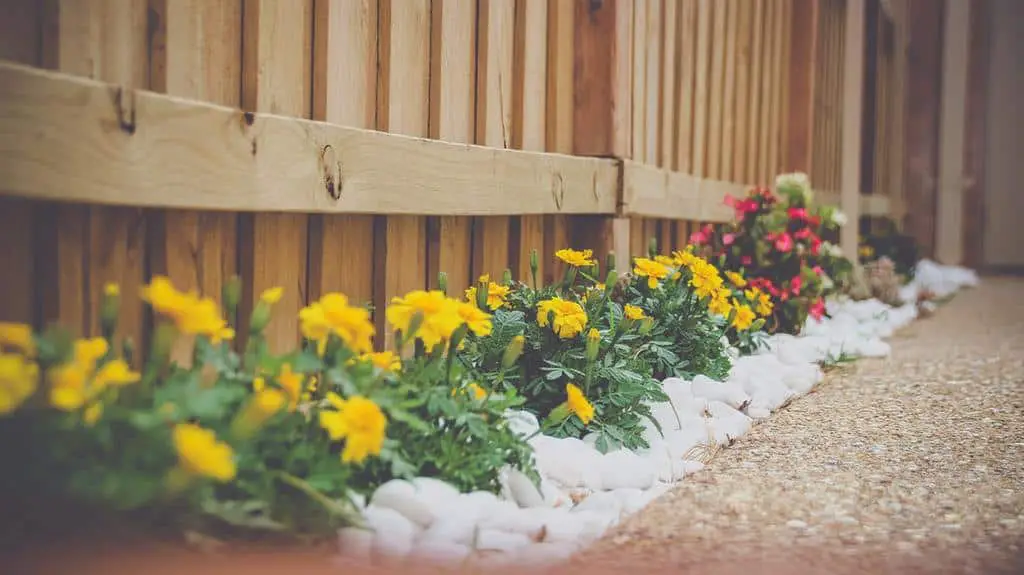
Make friends with neighbors whose gardens you admire. Ask them to think of you when the time comes to divide their hostas, ornamental grasses and other valued perennials.
Join the local garden club and attend their plant sales. This is usually an excellent way to buy choice plants inexpensively and you can usually receive good growing advice from these experts.
Beware of free plants unless you trust the source. Do not accept any plant that spreads easily. It may be invasive and take over your garden and you will forever regret planting it.
13. Xeriscaping
Xeriscaping is the newest term in low maintenance gardens using plants with low water requirements. The goal of xeriscaping is to build a sustainable garden that helps plants survive dry periods on their own, without heavy reliance on supplemental watering, fertilizer and other maintenance tasks.
Key elements in successful xeriscaped gardens are:
- Picking drought tolerant plants (consider a cactus garden)
- Proper planting procedure so plants get a good start
- Applying mulch to the soil surface to prevent water evaporation and inhibit weed growth
- Watering new plants for lengthy periods allowing water to penetrate deeply, until plants are established
14. Why Grow Native Plants
When choosing trees, shrubs and garden plants for your property, it is important to understand the difference between native and non-native species.
“Native” plants are those that evolved in your area and have adapted to the regional climate, soils and wildlife. “Non-native” species or “alien” plants were introduced from other parts of the world.
Although they are often very beautiful, non-native species can be invasive and may alter the ecosystem of an area. They can out-compete native plants and take over the landscape.
Native plants have natural controls like insects or disease to curb their growth, unlike the non-natives. Native plants are familiar to local wildlife and provide natural habitat and food for birds and butterflies. Because they have evolved to the local conditions, native plants are usually easier to grow; they conserve water and once established, require water only in the worst droughts.
Obviously, you can grow different kinds of cactus in Arizona but attempting to do so in Michigan would be pointless. Again, focus on the plants you most commonly see in your area or ask at your local nursery what does well in the region.

